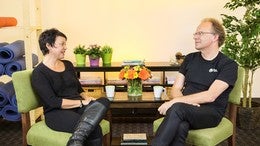Read Full Transcript
Chapter 1
The Start-Up Phase
This conversation is aimed to help people who are thinking of starting a Pilati studio. So I'm here with Carol Teresa and she's going to share some of her experiences and some of her advice with the community here to help people think through all the issues of the go with starting a new Palati studio. You know, some people would say it's foolishness to start a studio, but you've been very, very successful with it. Are there certain things you think have really contributed to that success? There are, I mean, I think the start startup is really pivotal and being successful.
What do you mean by that? What do you mean by the startup? The, the, that first year, those first few years? Um, I think there's an expectation today on a lot of young people who want to start their studios, that they need to have a fully equipped pimped out, ready to go studio. Um, so they need a lot of equipment. They need a website, they need everything, you know, the water bottles, a tee shirts and, and um, the capital investment there is just too high for what a startup Pilati studio a shop is what I call that is gonna make. So what, what would you recommend that you start with? So my recommendation when I, when I consult, um, for startup is to say, you know, start very small and, and you really, my recommendation is pay cash for every single thing that you need for your startup. You know, don't take out big loans, don't take, don't pour a big gigantic initial capital investment because Pilati is, is not going to pay you back that quickly.
And the most important thing is that you, yourself as the owner and probably the teacher, my guests at first or maybe forever pays themselves first. That's always the best business advice you pay yourself first. You take care of your overhead and then as you grow you can start to pay other people and include that in your business model. So would you start off with, you know, relatively small studio? Is that your recommendation with maybe one piece of each of equipment? What, what would you suggest as a good starting point?
I would suggest if I were just coming out and saying, you know, I'm going to leave the studio, I, I t chat, um, I'm not going to take the clients from them of course, because that's, that's not um, how we do things. So I'm going to start, yeah, I'm going to start small. I might rent a room in a somebody's wellness practice. Um, I might have a little space in a Cairo office or somewhere where I start to build a clientele where I can afford the overhead of rent. And I've been able to save money to buy my four pieces of equipment, which may be, I got on craigslist the first time because it was being sold secondhand, right? And then I wait until I have a clientele, a strong and jetted dedicated clientele. And I wait until my schedule is so full that I need a new teacher. And then I bring that next teacher in.
So if we're talking about that initial capital investment, you know, that small space. And what, what do you recommend in terms of a mixture of equipment? Huh. Um, you know, there's a lot of products out there today. I personally think in nowadays I would probably have bought one of those Combo units that allows for it to be a tower and a reformer. If you have a floor, you have a mat system. Um, I would probably have a chair because that's gonna be able to, a load chair that that's allowed to, to work with a diversity of people, clientele who come in. Um, different types of work. I would go probably in that direction, but there's a lot of less expensive modular stuff like the springboards, um, things that you could do in a small New York city environment or something.
But this idea of these gigantic studios hollow as I walk into them all over the world these days lined up reformers with, with not enough activity. This is not going to draw the client who walks by the window into this place. People want to go where the room is packed. So you pack your room and you, you, you expand when the room tells you that there's not enough room for everyone. Yeah. I know many people that start apart these business with their friends.
What do you feel about that? Do you think there's really a living in a polarity studio for two people? I don't. Um, I think owning a studio alone is your best way, first of all. Um, it's very hard to collaborate on a brand, um, and it's very hard. You're, your brand teaches you about yourself as you go along. So when there it for two people, that's it's too much. Um, and again, the, the, the industry is studios not going to profit. It's not gonna make that much money.
So you again want to pay yourself first as the owner and if you have to divide those profits, um, it's going to be a lot harder to be successful that way. Um, it's not that big of an undertaking that you can't do it on your own and then hire support staff along the way. The idea of wanting to do something together cause it seems like it'll be fun. I understand, but I've not seen that as a successful model. John, I really haven't.
Chapter 2
Building Your Client Base
You also mentioned that you don't bring your clients with them. You know, if you're working at else's studio you don't. So do you have any advice of how to him getting that, you know, building that initial client base?
Well, um, I think if you're on your own, um, starting, you've got to talk to your friends and family. You've got to take your business card everywhere you go, you have to go take classes, fitness classes and other parts of your community, you know, and talk to the person in the locker room who's ankle is sore from, from whatever they were doing and say, hey, have you ever tried PyLadies you have to go on, educate your community about what you do. You might want to offer. A few were, for instance, one of my new staff members is going to have an open house at my studio in December. Right? And she wants to invite all the people to come and she wants to show them what she's doing with her practice. It's a perfect way to meet new people. To invite them in. Um, but you have to be proactive. You have to get out there, you have to meet people, you have to introduce yourself, you have to offer, you know, hey John, do you want to come over and I'll do a free assessment of, of that knee Lyman that you're having your, the skiing.
I heard you're having a hard time skiing this winter. I have, I have a great, uh, answer for that stop by on Tuesday. Interesting. You know, and then I show you a couple things and you think, wow, this lady's smart. You know, even my so-and-so didn't tell me that. Um, but you have to be eager. You have to get out there and you have to educate. We have to educate the population in each of our communities, what we do and why would make such a profound difference in their lives. And it does. [inaudible] when I'm creating my studio, do you think that I should be focusing on a particular segment of the market or is that somewhat based on, you know, the location I have or your, do you have advice about, you know, should I be focusing more of a, uh, seniors or, yeah. So what's really wonderful question and I think it's, it's first of all, you're, you're rebranding and rechanging the s the, the, the brand and the culture of your studio all the time. You know, if you own something and you want it to keep going, you gotta be changing that constantly cause you're reassessing who's staying, what's your attrition level? Who's, who's, who's who, uh, whose days forever, if they've all stayed forever. Now they're all old. So I'm shifting my culture now, right? I have clients who've been with me 15, 16 years, so we, we are getting more focused on, wow, how do we serve our, our elderly population? Um, let's say you were in a community, um, a college based community, um, and you want to be working with the college students or the academic teachers, you're going to notice what your community is. Start that.
And then you're going to be changing that all the time as you see what the trends are. But you have to be watching the trends. Who's coming? I mean, we just, we just moved to a model where we have several classes on the equipment that are called that are four fifties up, right? I can almost take those classes at my studio now, um, 50s and up. And I thought, oh, I wonder if people are gonna lie if they're, you know, they're jam packed. These people were waiting to have a designated class for them where they could feel that not as self conscious, um, or, or more comfortable. We're also teaching movement for that body type and for the changes that that middle age bring. And so they feel actually specially a specialized support physically as well.
Do you think within the studio that you can have that over 50s group but also maybe serve of a young demo [inaudible] absolutely, absolutely. Absolutely. We are promoting a new program at aligned that's for skaters and dancers in their teen years, ice skaters and dancers. Cause I, one of my staff members that feels like a specialty for her and she wants to teach that. And so this is part of how you then promote and work with your staff, become experts and, and um, in their field. Um, but yes, I think you can do it across the board. Absolutely. Um, for as many, for as many people as there are in your neighborhood, you could be creating something that targets that them.
Chapter 3
Location Location Location
When you're picking the location of your first studio, do you think, um, that it should be, you know, essentially where you live that part of the community or do you think you should be targeting places within a commute distance that are perhaps less well-served than your own area? You know, as there are advantages of being kind of living and working in the same place as opposed to trying to analyze the market and determine where it looks like it's underserved. I think if you're starting up, you should live and work in that same area primarily because you're going to give your life away to your business and it's, you're going to be more likely to hop over to the studio, to take a client at the last minute or hop over to the studio to deal with the overflowing toilet.
If you don't have to get in the car for 30 minutes and for quite a long time, you're going to be everything. You're going to be the janitor, you're going to be the secretary, you're going to be the teacher, you're going to be, you know, I mean, so if you're far away, um, that becomes a strain on you. Also. You're in your own neighborhood. You're marketing by, by being at the grocery store, by saying, Oh yeah, that's my shop across the street. Um, stop by, uh, you know, you're, you're, you're really building within the community where your shop exists. And if you live in that community as well, you're going to be accessing more people. Yeah. Yeah. As a pilates teacher that's just beginning to find that first studio space, can you suggest some things? You know that, so they don't make the same mistakes as other people may. Yeah.
What's advice on trying to find a good space to begin that they will? First polarity studio. Okay. So let's, let's jump ahead a year. Let's say I've been doing this small practice that I've been talking about, right? Um, I've, I've grown up out of that, right? So I've been renting a room at a wellness center or something, and now I have, I have too many clients. I, I'm ready to bring some other teachers in.
It's time for me to go get my own dedicated space. Right. Um, and this scenario, actually, it happened to me. Um, you, you start to look for, um, places for rent. Um, my advice is to make sure that, um, you have, uh, a good legal person behind you, um, to help you learn and understand the way lease agreements work in business. Um, if you've rented a home or you've bought a home, it is not anything like, oh, having a triple net business lease. Um, so you need to learn, really get your, get your smarts on, know what these leases are, know what they, they, um, what you're signing. Um, you wanna make sure that that overhead is not even kind of a threat to your survival. Um, you don't want to cut your pay back to pay your rent. Um, you wanna make sure that it's a workable amount of money.
I would also say that, you know, over the years, I try to pick a space that I don't have to dedicate a lot of build out to cause whoever tells you your build out is going to be $10,000. Your build out is going to be $35,000 or more, and then suddenly you're, you're not gonna want the, the lamp fixtures that were there because they don't look as good. Now that you did the floors and now you need a lamp fixture, now you need [inaudible] and they all, your money's gone and now you're borrowing money. Right? These are, we're not big corporations and we shouldn't be borrowing big amounts of money unless we happen to have money because you aren't going to be paying back that big capital investment. So you want a bare bones space that's workable. Um, I recently found a place that had already been a gym, so I didn't have to, you know, frankly I put $7,000 into the build out. That was, that was workable. Yeah. I saved the $7,000 to pay the $7,000. Um, so you want to be sensible. So what about locations? Let's say that there's a, the studio just down the street from this location you're looking at.
What was your feeling about that? Um, I think there are enough people to go around and I think competition, healthy competition is fine. Um, I think it, you know, I mean it depends on what kind of city you live in. Um, in New York there, you know, there are plenty studios next to each other, you know, it's a dense city. Um, so I think you have to understand your demographics. Um, you know, I don't tend to want to move next door to another potty studio. Um, it feels aggressive to me. Um, but they're going to be simply students in your neighborhood and um, I think you make friends with them. Um, I think wherever you go, you become part of that community. Even if you offer the same service, you know, I might be open on Christmas Eve, she might be closed when it be nice if she tell her people to come on over and take our Christmas Eve class, there's no reason not to. Yeah. So I think you have to come in with a noncompetitive non aggressive approach if you're going to do that. Um, in terms of areas you want storefront, you want store front for plotting. You mean on the street? Yeah.
You went on the street exposure. I think it's much more difficult to be upstairs or in an office building. Um, you need signage, you need people to walk by. You need people to look in the window. Um, so when you think about that, looking in the window, you know, you thinking about it, there should be a curtain or should they be able to see people work? You're blind should be up all day long. You know, I have little kids who stare in the window every day.
I have people walking by their dogs, you know, we wave to them. The dogs come in when cause you know, suddenly I'm part of the neighborhood, the sidewalk becomes part of my studio. My studio becomes part of the sidewalk. And if one person who used to walk their dog every day suddenly comes out with a little limp because they sprained their ankle, he's going to stop in and say, you know, I noticed you guys have that thing you do with those people in their ankles cause I lived see that in the window. All of us, you know, you want to be, you want to spill out onto the sidewalks of your community. How do you try and make sure that the brand kind of fits your values of you?
Chapter 4
Developing Your Brand
You know, how, how did you develop your own brand?
You know, my, I feel like it was very organic. I did not brand and then try to fit in to my brand. I taught, I taught potties, I bought equipment I could afford to, um, my added equipment, I cash paid everything. Um, and little by little I think it was more my clientele who started to tell me by referring out to me what I was, um, that I was somebody who was helping people, um, have more freedom in their bodies or be more well or recovering from injury or cross training. Um, I became a part of my brand was to become a support system for other professionals in the industry. Um, once I started to read from my culture that was being created organically, I was able to, to, to hone my brand in a little bit and say, you know, Paul Audi's aligned is a full service [inaudible] studio serving both the community and the professional. Um, you know, the, the lay community and the professional community, um, that we are movement educators. That we are based on the tradition of helping people be more, uh, successful functionally. But that was, that wasn't a brand I picked and then tried to turn into, it was something that just teaching the good work that I taught and at my staff taught it, the brand came out of that. Um, and I think sometimes the cart gets before, uh, the horse and then the person feels very contracted around trying to fit into this, this fabricated thing that they've created. So you would encourage people to create the brand, which is who they are. Yes. Create the brand, which is who they are.
I have a friend right now who's starting a studio and she can't write her website. And I said, don't worry about it. If you can't write the website yet, you don't know what it is yet. She has a full client load. I said, just go to work in the morning and teach him. The website will come. Yeah. You know, but if we, if we make ourselves up to the point that we can't be organic and natural within that, then it's, it's very, very hard to, um, to feel comfortable within the context of that thing that we've created. [inaudible]
Chapter 5
Marketing
thinking about the marketing that you do to build out that customer base initially? Um, yeah. Are there any tools that you think are useful to yeah. As you start? Yeah, there are some, some very specific tools. Um, and they're not just about marketing.
They're also about customer service because your best marketing is having the best customer service and having the best customer service means that you make the process of coming to do plots in your studio. Easy, fun, confidence-building. I don't know how to say that right now, but you know, um, so you want, for instance, we use mind body online. My clients, it's a great customer service tool. They can book, they can change their mind. They get in last minute. I, I wanna know that they are watching what we're doing. Um, constant contact is also another way that we market. Um, within our audience space. Um, we do events, we have all sorts of changes, new classes, uh, playgrounds, different things that we do. And so we're always marketing within, within our community that way. Um, in terms of you can also overmarket your own base. And I think a lot of us in the industry do do that. Yeah. Email marketing is quite a complex issue. Um, you know, there's programs like MailChimp, constant contact, there's other ones.
What do you recommend for the frequency, the type of content you put in there? Oh, well, you know, we've learned as we, as we, uh, have gone in my studio, um, we send out at least we try to send out one month. We're using constant contact. Um, we have, when it comes to you, it's going to have a very particular look. You're always going to know it's the plot is aligned to newsletter. Um, and it's going to have a pretty broad, uh, a strong title so you know what the content is, you know, um, so, so you are interested in reading, um, less the less text, the better bullet points. Simple like this Thursday class in a glass, be there, you know, you don't need to send these long, um, uh, text lines out. You need to really just bullet point, let the client know what's going on.
Make them feel they're part of the thing you're doing, you know, you want to make sure every single one of these email blasts that comes out is, is, is like an invitation to something to the club they already belonged to. Um, so I don't need to school them. Right. Um, I find it very, very effective. Do you have any advice on which day of the week to send your emails? We like to send them on Mondays. [inaudible] in your emails, do you, do you put pictures always. And how'd you get the pictures?
Um, well we have some stock pictures. Um, I don't use any. Um, uh, we were always using pictures of us at the studio. I don't believe in using those sort of industrial, um, pictures. And I, I uh, I won't have that. Um, we need pictures. Sometimes I get pictures from anybody who will take a few shots at the studio. The girls take pictures of themselves for their own marketing and their own branding. Um, I put the Kibosh on a lot of pictures that come up on the constant contact emails and we'd go back and try again. If the picture doesn't look good. Um, the email's not going to work.
You know, Facebook is now a part of our society. It is. How would you recommend people use Facebook to promote their business? Um, we, we use Facebook. I actually have a person who is a dedicated marketing person. She also teaches plot is at the studio. Um, and she Facebooks at least twice a week if not more. For us.
We try not to over post, but we post all of the same events that we constant contact blast on. Um, we post, um, kind of immediately and let's say a class is not enrolled that week. You know, we might post four spots left and the 50s plus class today or you know, sometimes we'll do immediate posting also. Um, we use Twitter as well for that same thing. Um, and it's, it's extremely successful.
Chapter 6
Hiring and Retaining Staff
So we found this great location and you needed a couple of more, you know, one or two more employees to join you instructors to be part of the team. Yeah. Yeah. How do you pick the right people? It's a really good question. Um, and um, what I'm, how I'm going to answer that today is I'm going to pick somebody who's eager.
I'm actually gonna pick somebody who needs to make a living. John, you know, as much as I may really love my friend who's been teaching glottis also, who has three kids and whose husband makes a boatload of money and she wants to teach PyLadies, she's not really the person who's going to help me really make a profit on my company this year. I'm going to pick the person who's eager to work, who I know needs to make a living, who wants to be a professional pilates instructor. That's my first and most important thing that they are looking towards building a life as a movement educator and employees instructor. And they see a trajectory for themselves of where they want to go. I don't want the person stopping by, um, for a quickie, um, at this point. Um, so to me it doesn't matter, um, where they were trained. Um, I actually think it's quite lovely to have, um, people from different types of schools have plots because there are different community members who have heard of different schools and they might want somebody who's come from a different school than me at my studio. Um, but the person coming to work for me has to be a life learner and they have to not be held so tight around their training or their idea of themselves as a teacher, but rather come in with that seed and then become part of what we all are at the studio, which is where that culture starts to develop. Um, so there's a difference, but there is a sameness which has to do with the dedication, um, with the professionalism, with the, um, willingness to continue to change, grow and learn, uh, interest in, in your field and your profession. Um, so those are the things that I'm really looking at. Um, and it takes time to learn that I've hired lots of friends where it hasn't worked out. Um, I want to know that this person, um, is, is a dedicated plots professional because that's gonna create the customer service I need because customer services all ultimately excellence, excellence in your field, on your floor, across the board if you feel you've made a hiring error, if you hired the wrong person. Um, do you have any advice about how to deal with that?
Um, I have hired the wrong people and um, and it was wrong for me and it was also wrong for them. And I think that's a good thing to keep in mind as a boss that if the match isn't right for me, that matches not all, it's also not right for that individual because I'm going to be demanding something of this individual that they're not ready to take on yet and you need to tell them and they need to move along. Um, being a nice guy is not being a nice guy, being nice to yourself and keeping your studio the way you want. It is the most generous thing you're doing for your population of people who are coming and paying their good money and taking their good time to come do plots with you. So it sounds to me like if you are having a problem, deal with it, you have a problem, you deal with it, you change it. Um, I've had staff that I've let go of very quickly. I've had staff that I've worked very, very strongly with for many years to help build them to be more successful.
Um, you'll know, um, but, but yeah, it happens. You're also going to hire staff who are gonna open their own studios right next door to you. It's going to happen. It happens to everybody and it's going to be a heartbreak. Um, and you have to be prepared for that and, and set up those conversations early on when you're hiring, you know, verbal agreements in business go a long way. If you sit down with somebody on an interview and you say, listen, what would you do if your parents offered you $65,000 when you were working for me to open your own studio and take your 10 clients down the street from me? I'm just curious, do you think you would do that?
And what sort of answers do you get? [inaudible] they'll say, well, you know, I'm not thinking about doing anything like that. And I'm like, what I want you to know is if you did that, it would be extremely disappointing to me. So once you've, if you've had that conversation with me, John, and a year from now, you're walking out the door, you remember we've had that conversation at least. Yeah. So you want to be honest about your, what your needs are from somebody. I don't want to hire people who, who work at a neighboring studio down the street from me. That's not my culture. I want my staff, I want a dedicated staff too, to what we're doing in collaborating together. So you've successfully hired in a new employee.
What is the onboarding process? How do you train them? How do you set the tone right at the beginning? You know, I already have, you know, a we're, we're nine right now. Um, so in a real true scenario for me, if I bring somebody new on board, um, the, the first thing they have to understand is that they're, they're coming into a community that, um, and, and my staff becomes of the, they need to embrace that new person, take them around, introduce them to clients. They need to be subbing for each others classes so that we introduce that new person as fast as we can on the floor as part of the team. Um, W I, I am not, I don't find the model of each person having their own clients in my studio a successful model for me. For me, I want every client to be an aligned client and I want every staff member to be an aligned staff member because we're going to then take care of all those clients no matter who's schedule is changing, no matter what's happening in somebody's personal life. I don't know when somebody's going to have a baby, get married, break their leg.
I want to make sure that I don't lose half my client base because something's changing in the culture of Mike, my staff. So I'm going to bring that staff person on and make sure they understand right away. They are part of a culture. They are now a teacher of this entire studio. And any client that walks in that room is potentially somebody they'll see. So if that, you know, I have a new girl right now and I have a n a, a very elderly gentleman with Alzheimer's who's coming in and she was kind of like, Whoa, I'm glad that's not my client. I could see it in her eyes and guess what?
She sees them now somebody schedule changed. And that was a big step for her. And she's doing amazing with him. But you're going to come work for me. You're going to see anybody on my floor, whether they're the oldest, strangest, wacky, old guy or you know, uh, a professional baseball player. Um, so you gotta be ready to be part of that. You're a team. Um, and, uh, I think that's really important. Not, not just for the staff. It does bring the staff pride, but it's important that your clients can depend on your brand, on your, on your place of business. I don't want a client walking in ever going like a Shannon here. Oh, Shannon's not here. I don't want to be here. No, no, no, no. Shannon's not here, but I'm here. What do you need? Let's go.
Yeah. Do you have any advice for studio owners that are thinking of hiring their friends? Um, I do. I do. John. What I, what I, um, if, if you hire your friend, you have to then create a very, um, serious boundary as you become their boss because a boss can't be, so you're, you, you can't be friends with your staff. [inaudible] you know, as harsh as that might sound. Um, I'm the boss of my studio and I respect everybody who works for me. I'm down to the core, but the, when the lines get blurred with friendship, it's extremely confusing. Um, I, you know, you, you, this is a serious, um, endeavor to own a studio and to run a business and to stay viable and okay, you're the boss. People aren't gonna like you all the time, you know, that's just the way it goes. And you may end up having to fire somebody.
You could have a friend who's perpetually late. Somebody's perpetually late. My studio doesn't keep working for me. That's the end of a nice friendship. Cool. When you're setting your pricing for your various classes and privates, yeah.
Chapter 7
Determining Pricing
How do you determine, you know, do you charge more for yourself?
Do you charge more for the less experienced teachers? Yeah. How do you price versus the other studios in your community? So I'm going to look at the market and I'm actually going to use yoga studios as one of the market comparisons for my studio. Um, cause it's going to be the same group of people that are coming to mat classes are going to go to yoga classes. Um, so I'm gonna follow the market standard. Basically [inaudible] classes for us are going to get more expensive depending on equipment and teacher to student ratio. Um, because that, that has a value attached to it in my mind. Right? So if there's only three tier three students in one teacher, there's a value there of getting something closer to a private, your private is going to be your most expensive.
We keep our privates at what is considered at the market rate. In my town, I have made the choice that all this teacher's and my studio, no matter how senior, have the same pricing. Um, because again, like I explained, I don't want to alienate you. Let's say you're, you're a client of, of one of my new teachers and you pay and then you want to see me, but I'm three times as expensive or, or even $20 more expensive and you don't have that kind of budget that takes you away from me and my studio. So I don't want to create, um, n that division between me and my staff or the potential that somebody who wants to get on the schedule can't because I've, I'm a higher priced teacher. Um, so that's a choice I've made. Um, it's a choice that makes my staff also very, um, proud of me and happy that I don't, um, I don't charge more than them, so we're peers. We're equal. Um, which I think is part of building that culture of community and every, all the clients in my studio. No, I feel that way about my staff and I indeed I do. Um, which means that I'm going to help keep them booked.
Chapter 8
Should You Add Teacher Training?
Okay. Many studios work as both studios and teacher training facilities.
Yes. Um, do you think that that you can make that work? That's a great question. And um, I want to say to the, to the new startup person that we're speaking of, that starting a teacher training program and a studio at the same time is too much. You want a viable studio, you want a studio that is really, really working and taking care of itself. You're paying yourself off of your studio before you want to start a second business, which would be a teacher training program. One of the things I think I currently see John in the industry is that people start teacher training programs to support their studios. That's, that's, that's not, um, I, I don't think that's the, the smartest way to go. Your studio should support your studio. Your client base should be paying for your rent, for your marketing, for your salary, for your staff, for your toilet paper, for your taxes, for everything.
I don't want to have to start a teacher training program so I can cover my overhead, my teacher training program should be paying for me. And whoever else teaches that training program. It's marketing, it's website, it's own business. So they need to be separate. And if you're not bookkeeping them separately and seeing how they exist, they're cannibalizing off each other. And I think it's extremely scary because if one thing or the other goes down, you're gonna lose the whole thing.
And by this time now you've got more people involved and a lot of investment.
Chapter 9
The Future of Pilates Studios
How do you see the Palati studio business evolving over the next five years? Well, I think it needs a lot of, um, support. Uh, which is one of the reasons I wanted to do this conversation with you. The plot is, um, small studio, meaning private studio practice, um, growth in this country, um, I think is suffering right now. And I think, um, those of us who have been successful and who are dedicated to, um, carrying on this tradition of having small studio practices in, in the u s and abroad, um, we need to really be looking at, um, what works and duplicating that.
You know, and not all, not having everybody go out and doing their own new business model idea, but like actually let's, let's collect some data and look and see what w who, who's been successful here and why that if something is successful, it can be duplicated across, across the board. And that I think is what we want to see in this industry is really successful full on spotty studios throughout every community in this country. Um, there's room for franchises. Sure. There's room for gym activity. Sure. But let's not have that squeeze out the potential of individuals, shopkeepers and really successful small business.
And, um, what I think we need to do now is, is come together as a community and leaders who have been successful in creating business and say, what are some of the models that really work for success so that you as applaud the studio owner could be paying yourself a hundred plus thousand dollars a year and living a quite comfortable life and your staff could be making nice salaries and it's a win win for all that's actually possible. And I think at this point we really need to be building, um, faith in that and building a culture of [inaudible] professionals of individuals who really take themselves serious and know they can move forward and be successful in this field as a lifelong profession. Thank you. You're welcome.



































